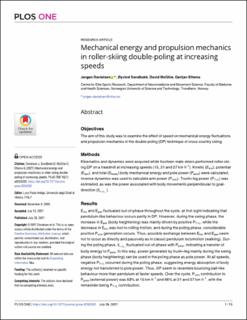| dc.description.abstract | Objectives The aim of this study was to examine the effect of speed on mechanical energy fluctuations and propulsion mechanics in the double-poling (DP) technique of cross-country skiing. Methods Kinematics and dynamics were acquired while fourteen male skiers performed roller-skiing DP on a treadmill at increasing speeds (15, 21 and 27 km∙h-1). Kinetic (Ekin), potential (Epot), and total (Ebody) body mechanical energy and pole power (Ppole) were calculated. Inverse dynamics was used to calculate arm power (Parm). Trunk+leg power (PT+L) was estimated, as was the power associated with body movements perpendicular to goal-direction (). Results Ekin and Epot fluctuated out-of-phase throughout the cycle, at first sight indicating that pendulum-like behaviour occurs partly in DP. However, during the swing phase, the increase in Epot (body heightening) was mainly driven by positive PT+L, while the decrease in Ekin was lost to rolling friction, and during the poling phase, considerable positive Parm generation occurs. Thus, possible exchange between Ekin and Epot seem not to occur as directly and passively as in classic pendulum locomotion (walking). During the poling phase, fluctuated out-of-phase with Ppole, indicating a transfer of body energy to Ppole. In this way, power generated by trunk+leg mainly during the swing phase (body heightening) can be used in the poling phase as pole power. At all speeds, negative PT+L occurred during the poling phase, suggesting energy absorption of body energy not transferred to pole power. Thus, DP seem to resemble bouncing ball-like behaviour more than pendulum at faster speeds. Over the cycle, Parm contribution to Ppole (external power) was 63% at 15 km∙h-1 and 66% at 21 and 27 km∙h-1, with the remainder being PT+L contribution. Conclusions When speed increases in level DP, both power production and absorption by trunk+leg actions increase considerably. This enhanced involvement of the legs at faster speeds is likely a prerequisite for effective generation of pole power at high speeds with very short poling times. However, the relative trunk+leg power contribution did not increase at the speeds studied here. | en_US |

